
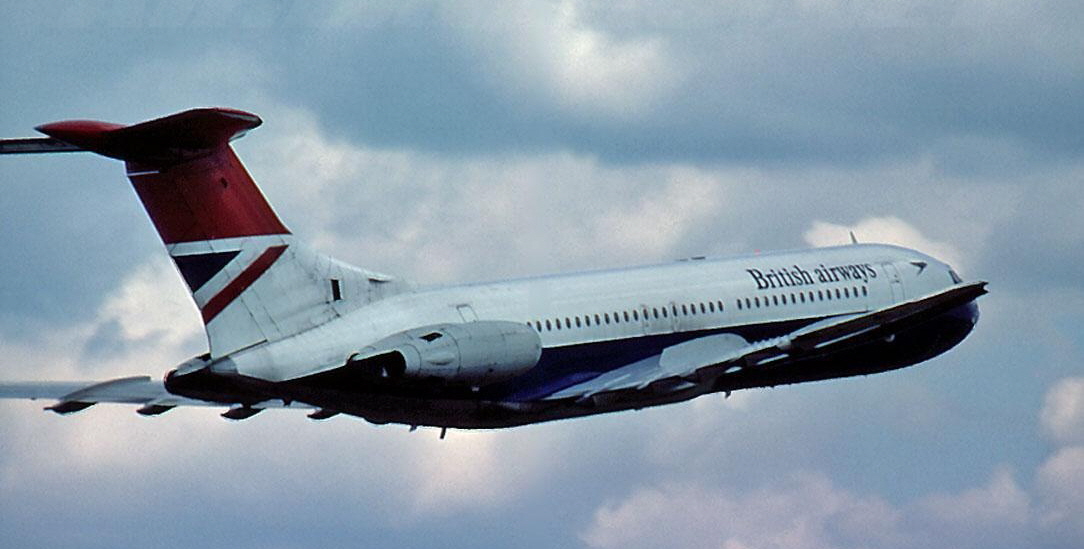 The Vickers VC10 was a long-range airliner designed and built by Vickers - Armstrong (Aircraft) Ltd, and first flown at Brooklands, Surrey, in 1962. The airliner was designed to operate on long-distance routes from the shorter runways of the era with a high subsonic speed, and demanded excellent hot and high performance for operations from African airports. The performance of the VC10 was such that it achieved the fastest London to New York crossing of the Atlantic by a jet airliner, a record still held to date for a sub-sonic airliner - only Concorde was faster. The VC10 is often compared to the larger Soviet Ilyushin Il-62, both aircraft having a rear-engined quad layout, the two types being the only airliners with such a configuration (a configuration that they shared with the earlier, but smaller Lockheed JetStar). Although only a relatively small number of VC10 aircraft were built (54), they provided long service with BOAC and other airlines from the 1960s to 1981. They were also used from 1965 as strategic air lifters for the Royal Air Force, and former passenger models and others were used as aerial refuelling aircraft. The 50th anniversary of the first flight of the prototype VC10 aircraft, G-ARTA, was celebrated with a 'VC10 Retrospective' Symposium and the official opening of a VC10 exhibition at Brooklands Museum on 29 June 2012. The type was finally retired from RAF service on 20 September 2013.
The Vickers VC10 was a long-range airliner designed and built by Vickers - Armstrong (Aircraft) Ltd, and first flown at Brooklands, Surrey, in 1962. The airliner was designed to operate on long-distance routes from the shorter runways of the era with a high subsonic speed, and demanded excellent hot and high performance for operations from African airports. The performance of the VC10 was such that it achieved the fastest London to New York crossing of the Atlantic by a jet airliner, a record still held to date for a sub-sonic airliner - only Concorde was faster. The VC10 is often compared to the larger Soviet Ilyushin Il-62, both aircraft having a rear-engined quad layout, the two types being the only airliners with such a configuration (a configuration that they shared with the earlier, but smaller Lockheed JetStar). Although only a relatively small number of VC10 aircraft were built (54), they provided long service with BOAC and other airlines from the 1960s to 1981. They were also used from 1965 as strategic air lifters for the Royal Air Force, and former passenger models and others were used as aerial refuelling aircraft. The 50th anniversary of the first flight of the prototype VC10 aircraft, G-ARTA, was celebrated with a 'VC10 Retrospective' Symposium and the official opening of a VC10 exhibition at Brooklands Museum on 29 June 2012. The type was finally retired from RAF service on 20 September 2013.
The VC10 was a new design but used some existing production ideas and techniques, as well as the Conway engines, developed for a previous Vickers design. It had a generous wing equipped with wide chord Fowler flaps and full span leading edge slats for good take-off and climb performance and its rear engines gave an efficient clean wing and reduced cabin noise. The engines were also higher up from the runway surface than an underwing design minimising damage from items like stones or debris on the runway - of importance considering the nature of the African runways. Technology included structural parts milled from solid blocks rather than assembled from sheet metal, which gave this aircraft immense strength. The following incident that occurred to a British Caledonian VC10 in June 1971 gives a good idea of the inherent strength of the design.
During a flight across the Andes from Buenos Aires, Argentina to Santiago in Chile, British Caledonian aircraft e G-ASIX got caught in a patch of clear air turbulence above the mountain peaks. The aircraft was thrown up on to its side at a 90-degree-plus back angle and then tossed, headlong, nose down towards the peaks a few thousand feet below (The mountains reaching up to 27.000 feet placed them close at hand) reaching speeds up to Mach 0.96 during the event. The severity of the upset caused the PCUs (power control units) on several flying control surfaces to be knocked out of action leaving the crew with an airplane plummeting downwards with speeds varying between the stall and high-speed buffet. With very little control authority the crew managed a recovery, resetting the other PCUs along the way. The airplane landed safely at its destination and after a thorough ground check was despatched on its next flight back home to Gatwick via Freetown. During the Freetown - Gatwick leg an unusual vibration was noticed in the airframe which increased in severity. On landing it became clear that a part of the leading edge of the stabiliser had detached and the leading edge spar of the fin was broken. Furthermore the wing torsion box turned out to be distorted with the wing tips bent upwards some four feet. The combined damage required a lengthy repair and only after several months in the hangar did G-ASIX fly again. The incident proved the strength of the VC10 airframe as other aircraft in previous similar situations had lost structural integrity and crashed. On an airliner with wing mounted engines the engine mounting pins would probably have snapped as the aircraft was spun around.
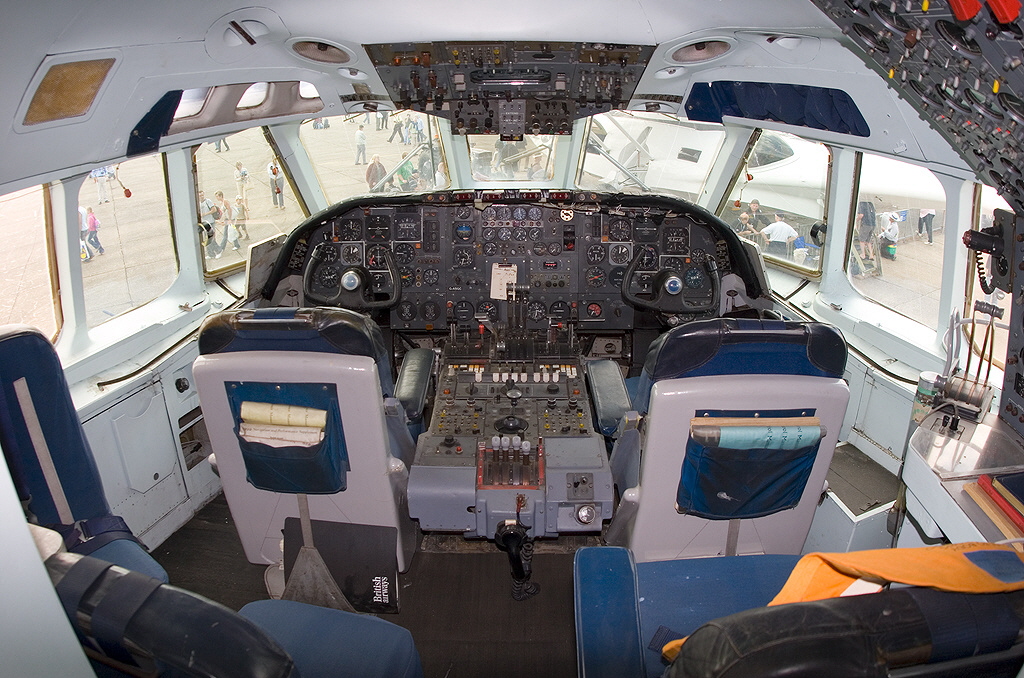
The Royal Air Force was the other major operator of this aircraft, initially using them world-wide as transport / passenger aircraft before converting them for an in-flight refuelling role role. Although the aircraft had been retired from commercial service many years before, the final flights of the VC10 in RAF service took place on 20 September 2013 when the final refuelling sortie was followed by a tour of the UK. On 24 September, RAF aircraft ZA150 had its last flight to Dunsfold Aerodrome for preservation at the Brooklands Museum, while aircraft ZA147 arrived at Bruntingthorpe on 25 September.
 The Boeing 777 is a long-range wide-body twin-engine jet airliner manufactured by Boeing Commercial Airplanes. It is the world's largest twinjet and has a capacity of over 300 passengers, with a range of 5,235 to 9,380 nautical miles, depending on model. Commonly referred to as the "Triple Seven", its distinguishing features include the largest-diameter turbofan engines of any aircraft, six wheels on each main landing gear, a circular fuselage cross-section and a blade shaped tail cone. Developed in consultation with eight major airlines, the 777 was designed to replace older wide-body airliners and bridge the capacity difference between the 767 and 747. As Boeing's first fly-by-wire airliner, it has computer-mediated controls; it is also the first entirely computer-designed commercial aircraft.
The Boeing 777 is a long-range wide-body twin-engine jet airliner manufactured by Boeing Commercial Airplanes. It is the world's largest twinjet and has a capacity of over 300 passengers, with a range of 5,235 to 9,380 nautical miles, depending on model. Commonly referred to as the "Triple Seven", its distinguishing features include the largest-diameter turbofan engines of any aircraft, six wheels on each main landing gear, a circular fuselage cross-section and a blade shaped tail cone. Developed in consultation with eight major airlines, the 777 was designed to replace older wide-body airliners and bridge the capacity difference between the 767 and 747. As Boeing's first fly-by-wire airliner, it has computer-mediated controls; it is also the first entirely computer-designed commercial aircraft.
The 777 ranks as one of Boeing's best-selling models, selling over 1,000 aircraft to date. Because of rising fuel costs, airlines have acquired the type as a comparatively fuel-efficient alternative to other wide-body jets and have increasingly deployed the aircraft on long-haul transoceanic routes. Direct market competitors have included the Airbus A330-300, A340, McDonnell Douglas MD-11 and the A350. The new Boeing 787 Dreamliner, which entered service in 2011 with All Nippon Airways, shares design features with the 777.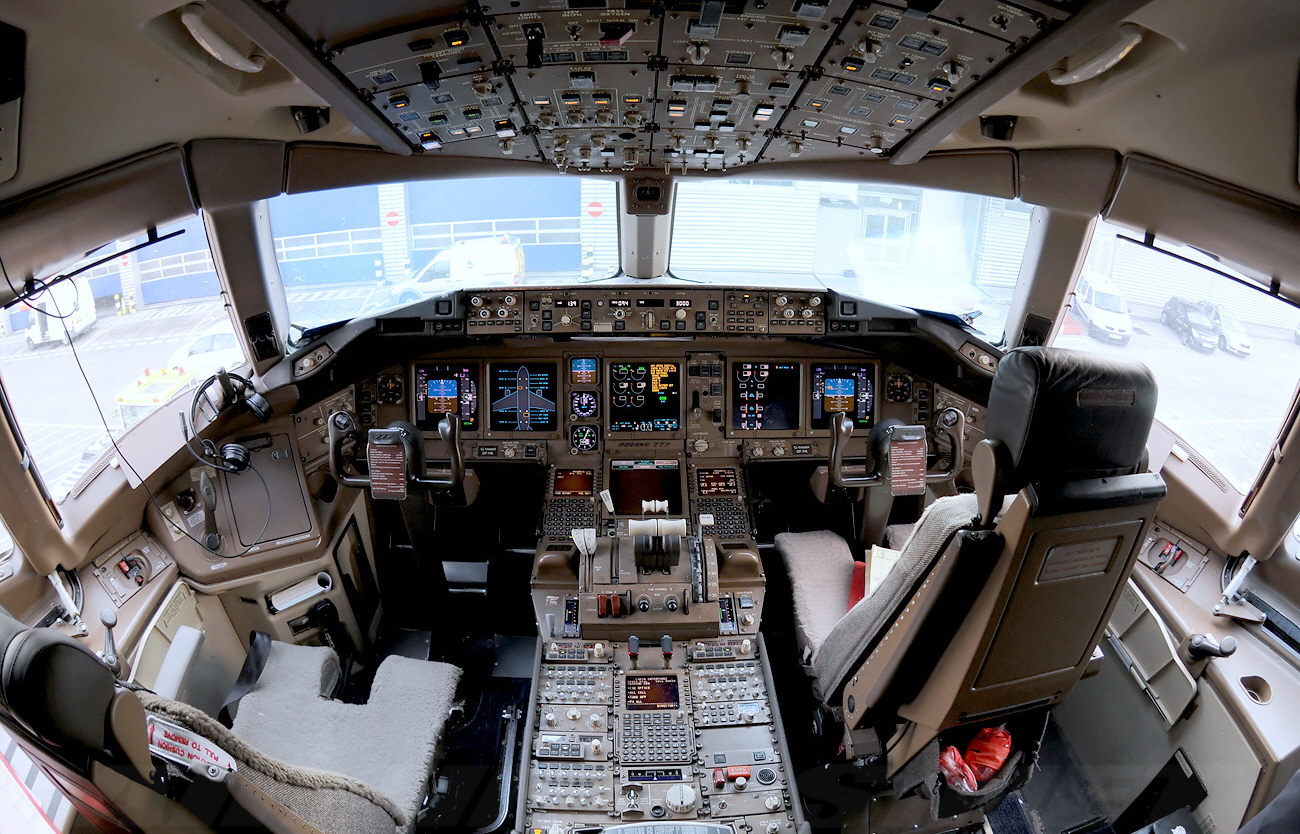
Boeing introduced a number of advanced technologies with the 777 design, including fully digital fly-by-wire controls, fully software-configurable avionics, glass cockpit flight displays, and the first use of a fibre optic avionics network on a commercial airliner. In designing the 777 as its first fly-by-wire commercial aircraft, Boeing decided to retain conventional control yokes rather than change to sidestick controllers as used in many fly-by-wire fighter aircraft and in many Airbus airliners. Along with traditional yoke and rudder controls, the cockpit features a simplified layout that retains similarities to previous Boeing models. The fly-by-wire system also incorporates flight envelope protection, a system that guides pilot inputs within a computer-calculated framework of operating parameters, acting to prevent stalling and overly stressful manoeuvres. This system can be overridden by the pilot in command if deemed necessary, unlike the similar system on Airbus designs.
This was the first aircraft that Tim Orchard flew commercially as a British Airways Captain.
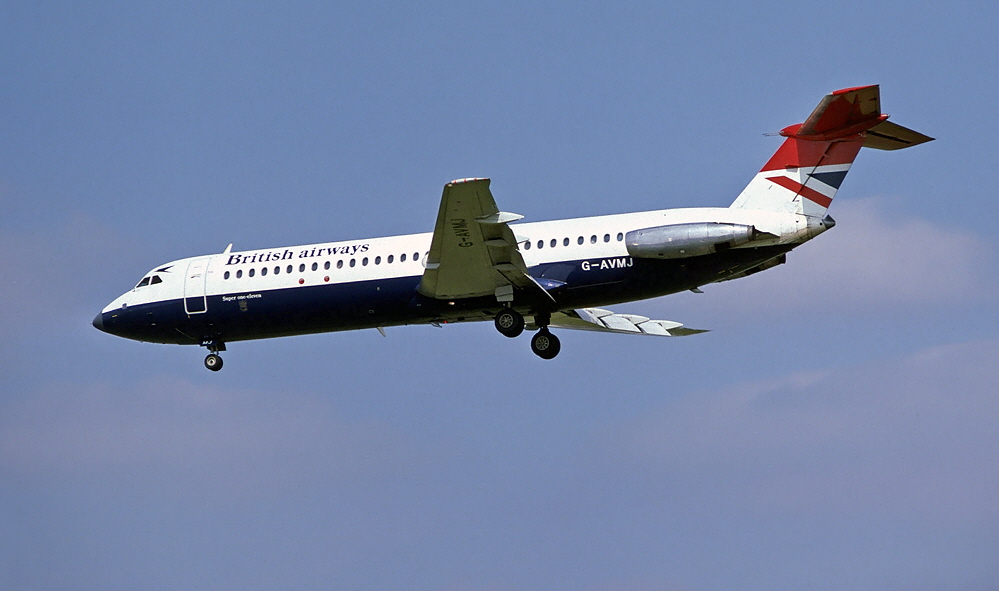 The British Aircraft Corporation One-Eleven, also known as the BAC 1-11 (and informally, The Pocket Rocket), was a short range jet airliner of the 1960s and 1970s. Conceived by Hunting Aircraft, it was developed and produced by the British Aircraft Corporation when Hunting merged into BAC along with other British aircraft makers in 1960.
The British Aircraft Corporation One-Eleven, also known as the BAC 1-11 (and informally, The Pocket Rocket), was a short range jet airliner of the 1960s and 1970s. Conceived by Hunting Aircraft, it was developed and produced by the British Aircraft Corporation when Hunting merged into BAC along with other British aircraft makers in 1960.
The One-Eleven was designed to replace the Vickers Viscount on short-range routes. Following the French Sud Aviation Caravelle, it was the second short-haul jet airliner to enter service. This gave it the advantage of more efficient engines and previous jet-airliner experiences, making it a popular model; over half its sales at launch were to the largest and most lucrative market, the United States. The One-Eleven made it to market ahead of rivals such as the McDonnell Douglas DC-9, which gave it a temporary edge on the market. The One-Eleven was one of the most successful British airliner designs, selling 244 aircraft world-wide, and served until its widespread retirement in the 1990s due to noise restrictions.
Several British operators, including Dan Air and British Caledonian, made extensive use of the type. Dan Air progressively increased the number of One-Elevens they had in service in the 1970s, eventually replacing their ageing first-generation de Havilland Comets with the One-Eleven entirely in the 1980s, with the type becoming the airline's main revenue generator. Dan Air would often lease One-Elevens to meet short-term demands; during periods of low demand Dan Air would also lease its own One-Elevens out to other operators; British Caledonian and Dan Air One-Elevens would often be exchanged between the two airlines on temporary and permanent arrangements. Passenger demand grew on several key One-Eleven routes, exceeding even the BAC 1-11 Series 500 aircraft’s larger capacity during the 1980s, which began to force airlines to use other planes. British Caledonian had begun replacing their One-Elevens with the new Airbus A320, when they were merged with British Airways in 1988 . In both Caledonian and British Airways service, the One-Elevens were a dominant type for the operator's European routes.
Prior to the formation of British Airways (BA), some of its predecessor companies, British European Airways and Cambrian Airways, had been operating the 1-11. British European Airways / British Airways 500 series aircraft varied significantly from other 1-11s, at the request of BEA. Their aircraft had a modified cockpit which incorporated instrumentation and avionics from or similar to that of the Hawker Siddeley Trident, for better commonality with the type. Their additional equipment included a more sophisticated autoflight system, which allowed autolandings and included an autothrottle. The modifications went as far as reversing the "on" position of most switches to match that of the Trident; indeed, this version of the 1-11 was so different from other 1-11 series aircraft that a different type rating was required to fly it. Their fleets would be inherited by BA; British Airways Regional Division found the performance of the One-Eleven more than adequate and sought to expand the airline's operations with the type, including further acquisitions, in the early 1970s in part to replace remaining Vickers Viscounts. BA's 400-Series One-Elevens all received names after areas and locations in the English Midlands, reflecting the type's new base at Birmingham Airport. BA ordered more Series-500 aircraft in the late 1970s and the airline received some of the last British-made One-Elevens.
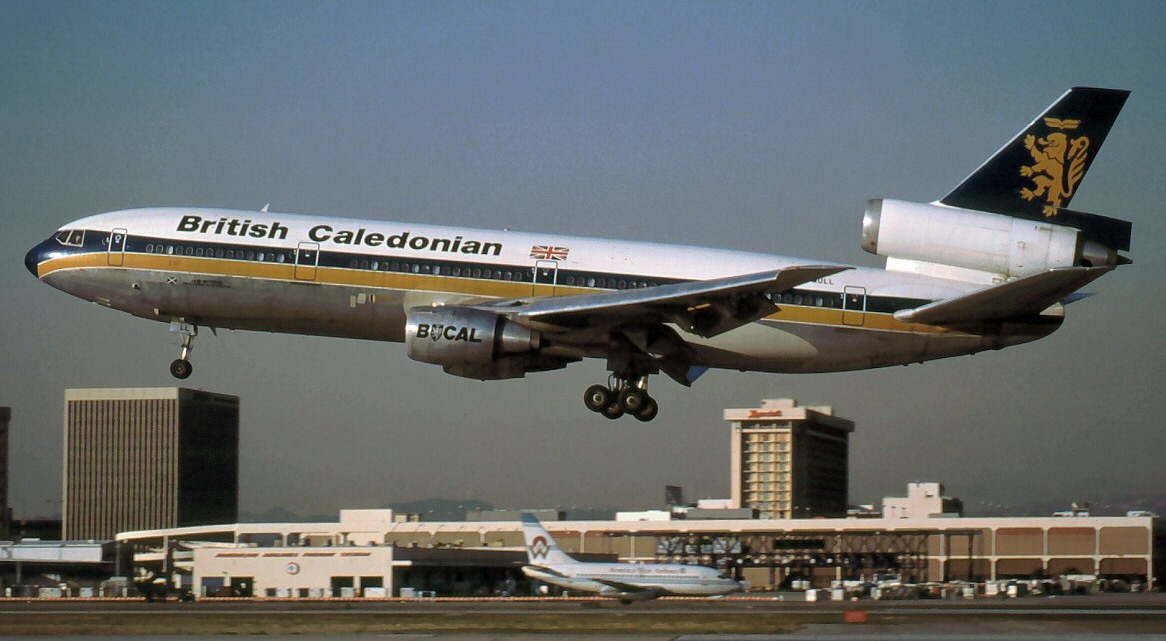 The McDonnell Douglas DC-10-30 is a three-engine widebody jet airliner manufactured between 1971 and 1989. The DC-10 has sufficient range for medium to long-haul flights, capable of carrying a maximum 380 passengers. Its most distinguishing feature is the two turbofan engines mounted on underwing pylons and a third engine at the base of the fin. The model was a successor to the McDonnell Douglas DC-8 for long-range operations, and competed in the same markets as the Lockheed L-1011 Tristar, which has a similar layout to the DC-10.
The McDonnell Douglas DC-10-30 is a three-engine widebody jet airliner manufactured between 1971 and 1989. The DC-10 has sufficient range for medium to long-haul flights, capable of carrying a maximum 380 passengers. Its most distinguishing feature is the two turbofan engines mounted on underwing pylons and a third engine at the base of the fin. The model was a successor to the McDonnell Douglas DC-8 for long-range operations, and competed in the same markets as the Lockheed L-1011 Tristar, which has a similar layout to the DC-10.
The series 30 was the longer range "international" version of the original medium range DC-10-10. One of the main visible differences between the models is that the series 10 has three sets of landing gear (one front and two main) while the series 30 has four sets of landing gear (one front, one in each wing and one in the centre fuselage). The centre main two - wheel landing gear (which extends from the centre of the fuselage) was added to accommodate the extra weight of the -30 variant by distributing the weight and providing additional braking. The series 30 had an absolute maximum range of 6,220 miles, which came down to a maximum range with a full payload of 4,604 miles. 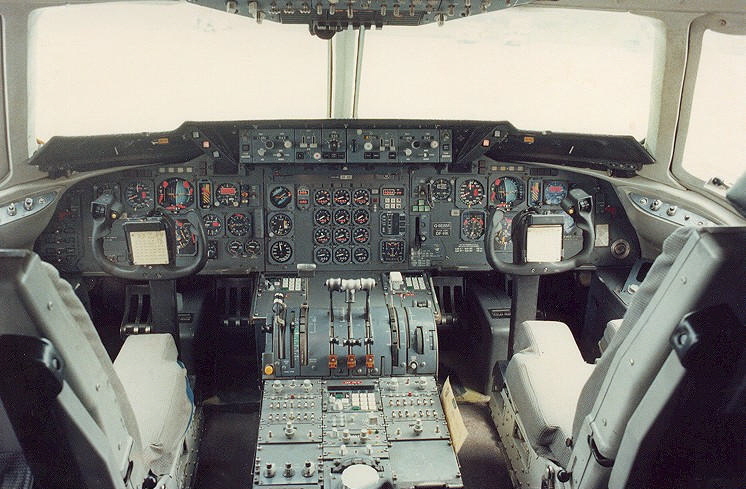
Eventually, the DC-10 became the best known and most popular of the three-engined airliners. They eventually built 446 of these aircraft in their different variants with the last and final DC-10 being rolled off the production line in December 1988 destined for Nigeria Airways in July 1989. Biman Bangladesh Airlines was the last commercial carrier to operate the DC-10 in passenger service and their last regularly scheduled DC-10 passenger flight was on December 7, 2013. The airline flew the DC-10 on a charter passenger flight on February 20, 2014, from Dhaka, Bangladesh to Birmingham, UK. Local charter flights were also flown until February 24, 2014. As of July 2013, there were 69 DC-10s and MD-10s in airline service as dedicated freighter aircraft with operators FedEx Express (62 aircraft), Kelowna Flightcraft Air Charter (4 aircraft), and 3 freight aircraft with smaller airlines.
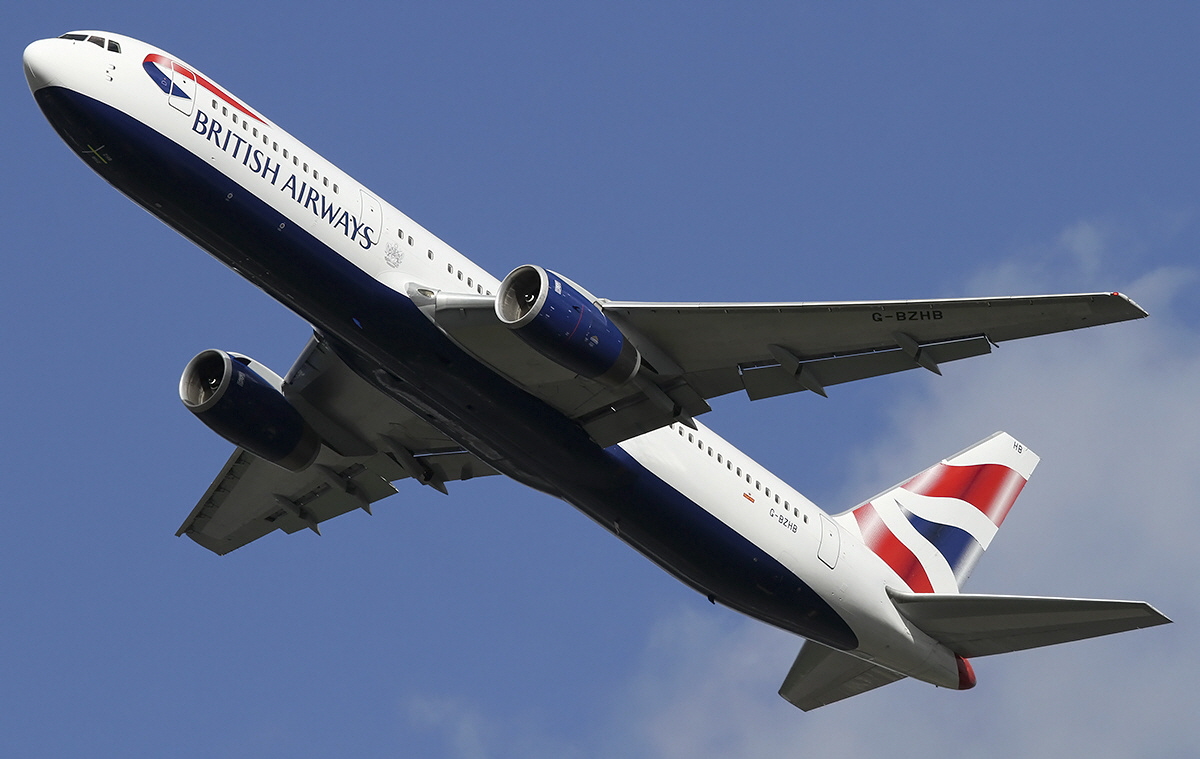 The Boeing 767 is a mid- to large-size, long-range, wide-body twin-engine jet airliner built by Boeing Commercial Airplanes. It was the manufacturer's first wide-body twinjet and its first airliner with a two crew glass cockpit with colour displays and new electronics replaced the role of the Flight Engineer by enabling the pilot and co-pilot to monitor aircraft systems directly. Despite the promise of reduced crew costs, United Airlines initially demanded a conventional three-person cockpit, citing concerns about the risks associated with introducing a new aircraft. A three-crew cockpit remained as an option and was fitted to the first production models. Ansett Australia ordered 767 aircraft with three-crew cockpits due to union demands; it was the only airline to operate 767 aircraft so configured. Development of the 767 occurred in tandem with a narrow-body twinjet, the 757, resulting in shared design features which allow pilots to obtain a common type rating to operate both aircraft.
The Boeing 767 is a mid- to large-size, long-range, wide-body twin-engine jet airliner built by Boeing Commercial Airplanes. It was the manufacturer's first wide-body twinjet and its first airliner with a two crew glass cockpit with colour displays and new electronics replaced the role of the Flight Engineer by enabling the pilot and co-pilot to monitor aircraft systems directly. Despite the promise of reduced crew costs, United Airlines initially demanded a conventional three-person cockpit, citing concerns about the risks associated with introducing a new aircraft. A three-crew cockpit remained as an option and was fitted to the first production models. Ansett Australia ordered 767 aircraft with three-crew cockpits due to union demands; it was the only airline to operate 767 aircraft so configured. Development of the 767 occurred in tandem with a narrow-body twinjet, the 757, resulting in shared design features which allow pilots to obtain a common type rating to operate both aircraft.
In February 1990, the first 767 equipped with Rolls-Royce RB211 turbofans, a 767-300, was delivered to British Airways. Six months later, the carrier temporarily grounded its entire 767 fleet after discovering cracks in the engine pylons of several aircraft. The cracks were related to the extra weight of the RB211 engines, which are 2,205 pounds (1,000kg) heavier than other 767 engines. During the grounding, interim repairs were conducted to alleviate stress on engine pylon components, and a parts redesign in 1991 prevented further cracks. Boeing also performed a structural reassessment, resulting in production changes and modifications to the engine pylons of all 767 aircraft in service
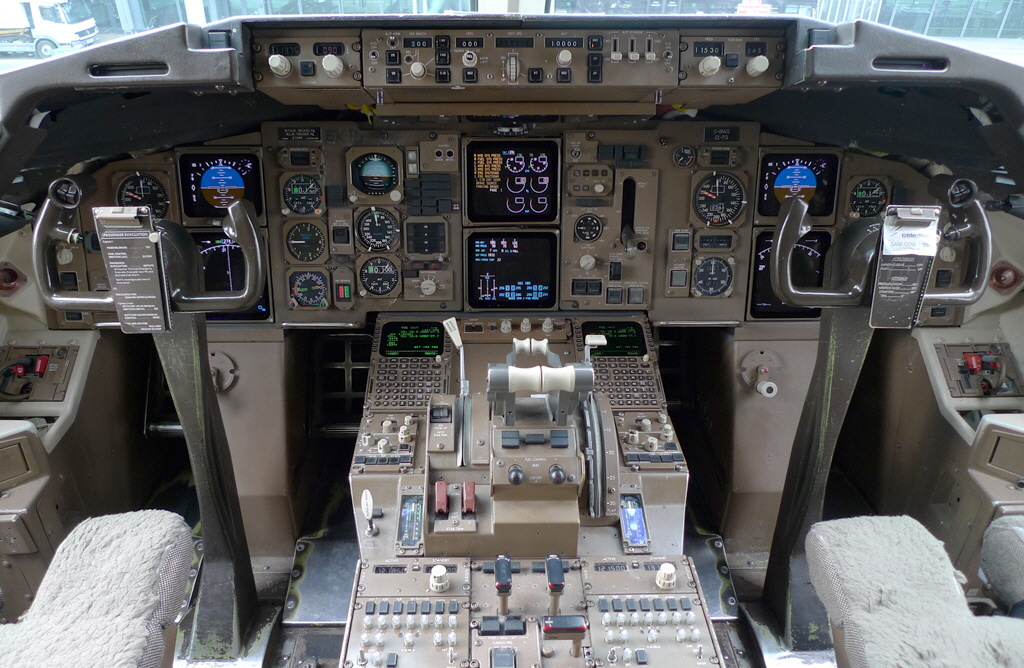 United Airlines first placed the 767 in commercial service in 1982. The aircraft was initially flown on domestic and transcontinental routes, during which it demonstrated the reliability of its twinjet design. In 1985, the 767 became the first twin-engined airliner to receive regulatory approval for extended overseas flights. The aircraft was then used to expand non-stop service on medium- to long-haul intercontinental routes. In 1986, Boeing initiated studies for a higher capacity 767, ultimately leading to the development of the 777, a larger wide body twinjet. In the 1990s, the 767 became the most frequently used airliner for transatlantic flights between North America and Europe.
United Airlines first placed the 767 in commercial service in 1982. The aircraft was initially flown on domestic and transcontinental routes, during which it demonstrated the reliability of its twinjet design. In 1985, the 767 became the first twin-engined airliner to receive regulatory approval for extended overseas flights. The aircraft was then used to expand non-stop service on medium- to long-haul intercontinental routes. In 1986, Boeing initiated studies for a higher capacity 767, ultimately leading to the development of the 777, a larger wide body twinjet. In the 1990s, the 767 became the most frequently used airliner for transatlantic flights between North America and Europe.
The 767 is the first twinjet wide-body type to reach 1,000 aircraft delivered and the 777 ranks as one of Boeing's best selling models, with 1,061 aircraft built to February 2014. The most popular variant is the 767-300ER, with 582 delivered; Delta Air Lines is the largest operator, with 94 aircraft. British Airways has 21 767-300 aircraft in the fleet, mostly used on the trans-Atlantic routes as well as some European destinations. Because of rising fuel costs, airlines have acquired the type as a comparatively fuel-efficient alternative to other wide body jets and have increasingly deployed the aircraft on long-haul transoceanic routes.
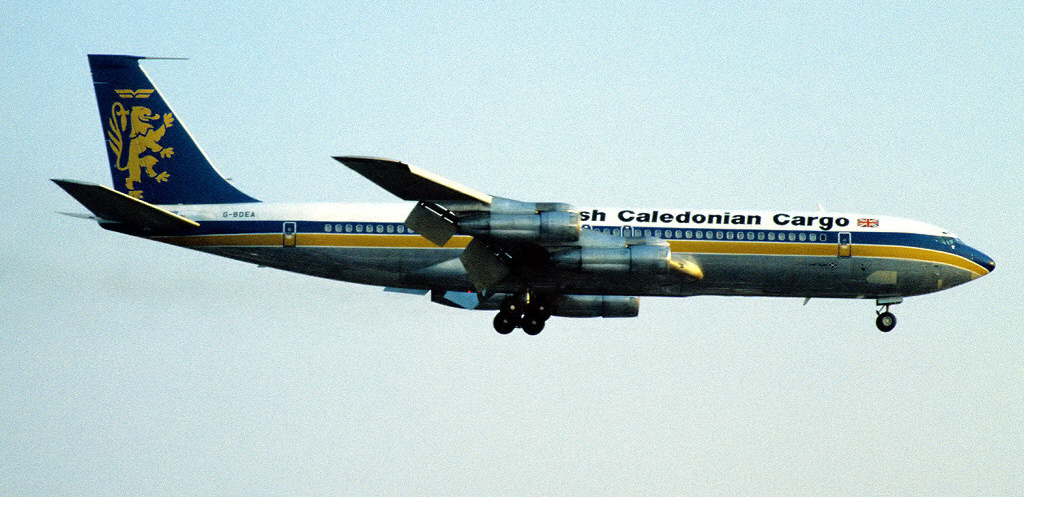 The Boeing 707 is a mid-size, narrow-body four-engine jet airliner that was manufactured by Boeing Commercial Airplanes from 1958 to 1979. Versions of the aircraft have a capacity of 140 to 202 passengers and a range of 3,680 to 3,735 nautical miles. Developed as Boeing's first jet airliner, the 707 features a swept-wing design with podded engines. the 707 is generally credited with ushering in the Jet Age. Although the distinction of being the first jetliner in service goes to the De Havilland Comet aircraft, the 707 was the first to be commercially successful world-wide and dominated passenger air transport in the 1960s, and remaining common throughout the 1970s. It established Boeing as one of the largest manufacturers of passenger aircraft, and led to the later series of aircraft with "7x7" designations. The subsequent 727, 737, and 757 also share elements of the 707s fuselage design.
The Boeing 707 is a mid-size, narrow-body four-engine jet airliner that was manufactured by Boeing Commercial Airplanes from 1958 to 1979. Versions of the aircraft have a capacity of 140 to 202 passengers and a range of 3,680 to 3,735 nautical miles. Developed as Boeing's first jet airliner, the 707 features a swept-wing design with podded engines. the 707 is generally credited with ushering in the Jet Age. Although the distinction of being the first jetliner in service goes to the De Havilland Comet aircraft, the 707 was the first to be commercially successful world-wide and dominated passenger air transport in the 1960s, and remaining common throughout the 1970s. It established Boeing as one of the largest manufacturers of passenger aircraft, and led to the later series of aircraft with "7x7" designations. The subsequent 727, 737, and 757 also share elements of the 707s fuselage design.
During its service career, the 707 has been used in a variety of roles, including domestic, transcontinental, and transatlantic operations. The 707 has also been used for cargo and military applications. A convertible passenger / freighter model, the 707-320C, entered service in 1963, and passenger 707s have been modified to freighter configurations. Military derivatives include the E-3 Sentry airborne reconnaissance aircraft and the C-137 Stratoliner VIP transports. During the 707s production run, Boeing produced and delivered a total of 1,011 aircraft, including the slightly smaller 720 series, in addition to over 800 military versions being produced. As of July 2013, only 10 examples of the 707 remain in airline service round the world.
Pete Carrigan cut his teeth working on the Boeing 707 as a licensed Engine and Airframe Ground Engineer, and this was the first aircraft type flown in their civil flying careers by both Pete Finlay and John Hutchinson
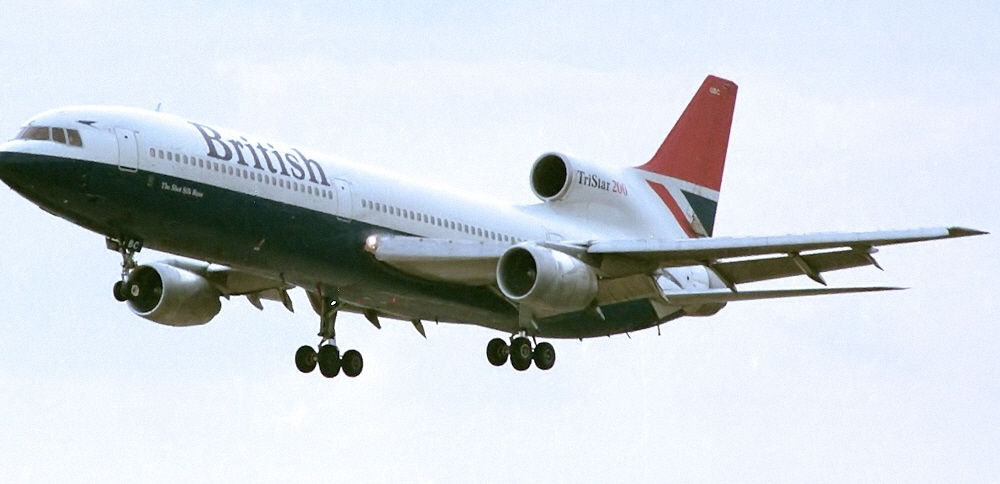 The Lockheed L-1011 TriStar, commonly referred to as the L-1011 (pronounced "L-ten-eleven") or TriStar, is a medium-to-long-range, wide-body trijet airliner. It was the third widebody airliner to enter commercial operations, after the Boeing 747 and the McDonnell Douglas DC-10. The aircraft has a seating capacity of up to 400 passengers and a range of over 4,000 nautical miles (7,410 km). Its trijet configuration places one Rolls-Royce RB211 engine under each wing, with a third, centre - mounted RB211 engine with an S-duct air inlet embedded in the tail and the upper fuselage. The main visible difference between the TriStar and its similar trijet competitor, the McDonnell Douglas DC-10, is the middle / tail engine: the DC-10's engine is mounted above the fuselage for simplicity of design and more economical construction, while the TriStar's No 2 engine is mounted to the rear fuselage and fed through an S-duct (similar to the Boeing 727) for reduced drag, improved stability, and easier replacement. The aircraft has a sophisticated autoland capability, an automated descent control system, and also available, dependant upon airline specifications, a lower deck galley and lounge facilities.
The Lockheed L-1011 TriStar, commonly referred to as the L-1011 (pronounced "L-ten-eleven") or TriStar, is a medium-to-long-range, wide-body trijet airliner. It was the third widebody airliner to enter commercial operations, after the Boeing 747 and the McDonnell Douglas DC-10. The aircraft has a seating capacity of up to 400 passengers and a range of over 4,000 nautical miles (7,410 km). Its trijet configuration places one Rolls-Royce RB211 engine under each wing, with a third, centre - mounted RB211 engine with an S-duct air inlet embedded in the tail and the upper fuselage. The main visible difference between the TriStar and its similar trijet competitor, the McDonnell Douglas DC-10, is the middle / tail engine: the DC-10's engine is mounted above the fuselage for simplicity of design and more economical construction, while the TriStar's No 2 engine is mounted to the rear fuselage and fed through an S-duct (similar to the Boeing 727) for reduced drag, improved stability, and easier replacement. The aircraft has a sophisticated autoland capability, an automated descent control system, and also available, dependant upon airline specifications, a lower deck galley and lounge facilities.
The L-1011 TriStar was produced in two fuselage lengths. The original L-1011-1 first flew in November 1970, and entered service with Eastern Air Lines in 1972. The shortened, long-range L-1011-500 first flew in 1978, and entered service with British Airways a year later. The original length TriStar was also produced as the high gross weight L-1011-100, uprated engine L-1011-200, and further upgraded L-1011-250. Post-production conversions for the L-1011-1 with increased takeoff weights included the L-1011-50 and L-1011-150.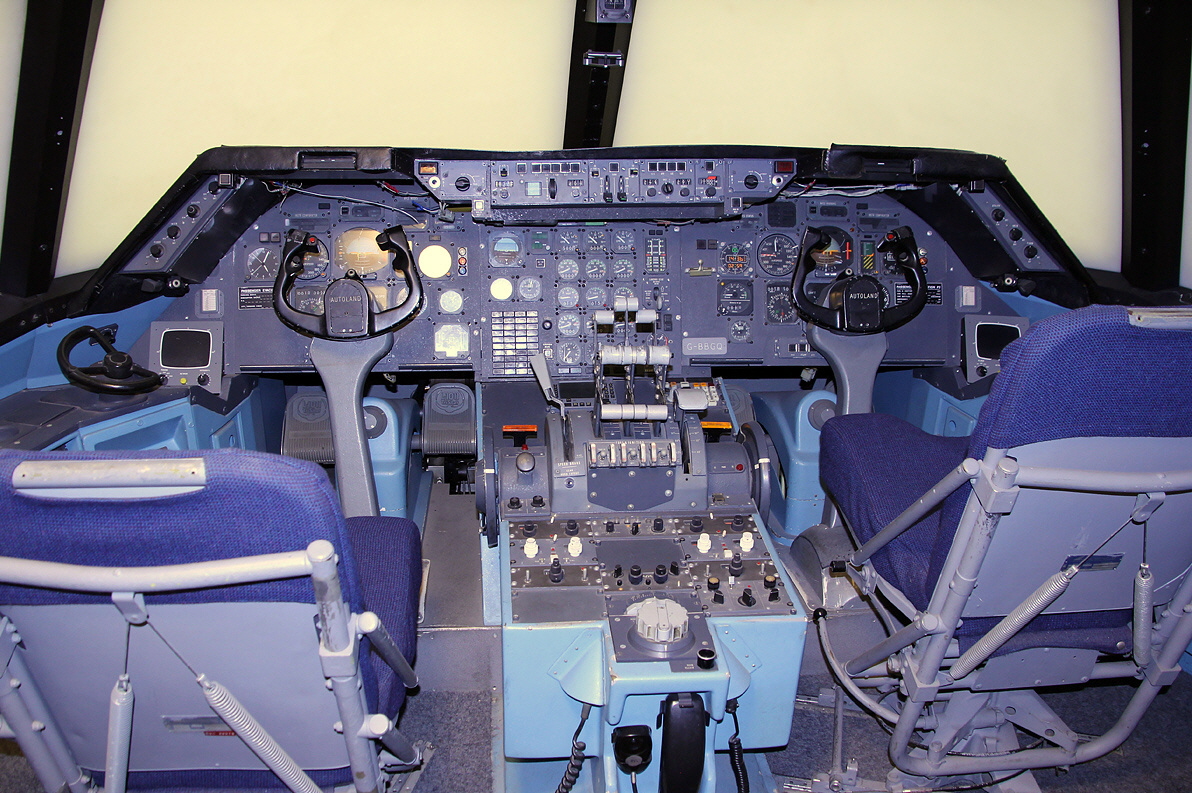
Between 1968 and 1984, Lockheed manufactured a total of 250 TriStars, compared to 446 DC-10s, partly because of the TriStar's delayed introduction but particularly because a larger version with a longer range was not initially offered. The aircraft's sales were hampered by two years of delays due to developmental and financial problems at Rolls-Royce, the sole manufacturer of the TriStar's engines. Under state control, costs at Rolls-Royce were tightly controlled. The company's efforts largely went into the original TriStar engines, which needed considerable modifications between the L-1011's first flight and service entry. The competition, notably General Electric, were very quick to develop their CF6 engine with more thrust, which meant that a heavier "intercontinental" DC-10-30 could be more quickly brought to market. The flexibility afforded to potential customers by a long-range DC-10 put the L-1011 at a serious disadvantage. Rolls-Royce went on to develop the high-thrust RB211-524 for the L-1011-200 and -500, but this took many years. After production ended, Lockheed withdrew from the commercial aircraft business due to its below-target sales. As of 2014 there were only 17 Tristar aircraft operational in the world.
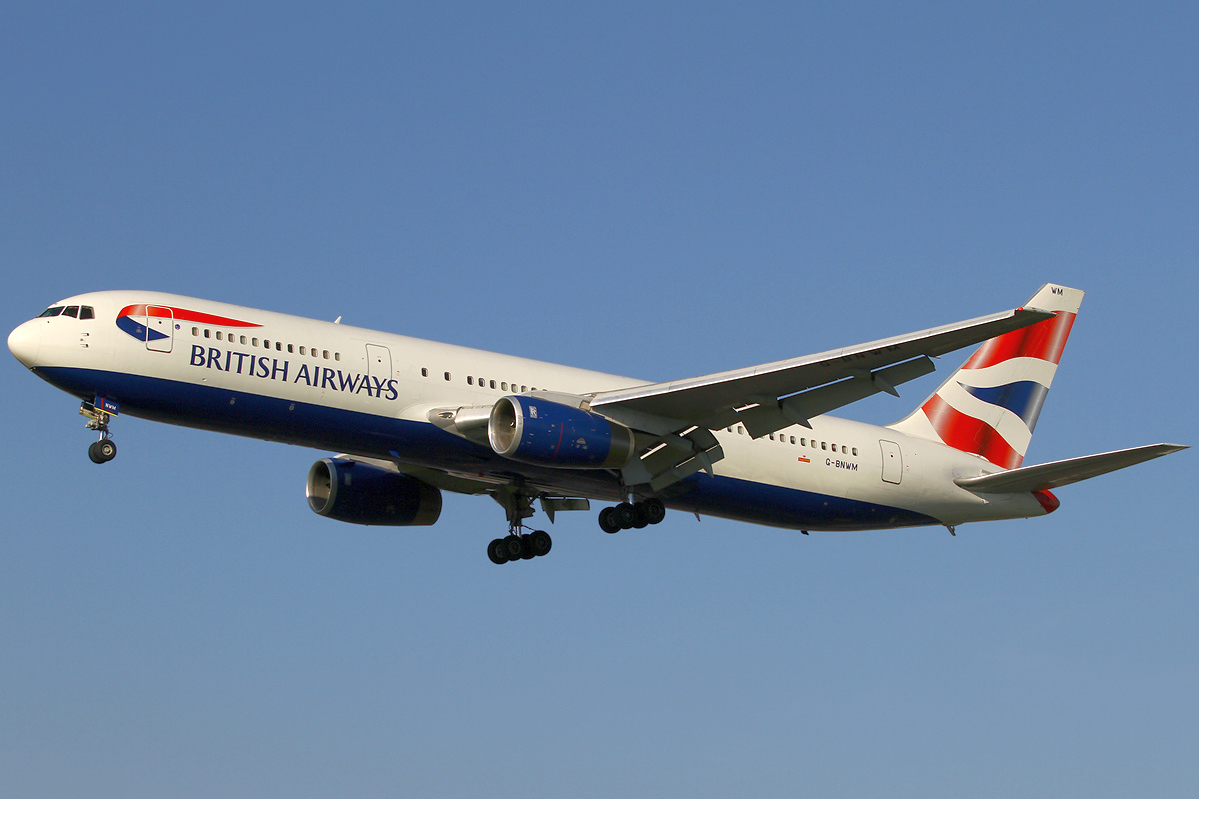 The 767-300ER, the extended-range version of the 767-300, entered service with American Airlines in 1988. The type's increased range is made possible by greater fuel capacity and a higher Maximum Take Off Weight of 407,000 pounds (185,000 kg), giving it a maximum range of 7,260 statute miles (11,690 km). Design improvements allowed the available Maximum Take Off Weight to increase to 412,000 pounds (187,000 kg) by 1993. Power is provided by either Pratt & Whitney PW4000, General Electric CF6, or Rolls-Royce RB211 engines.Typical routes for the type include Los Angeles to Frankfurt. The combination of increased capacity and range offered by the 767-300ER has been particularly attractive to
The 767-300ER, the extended-range version of the 767-300, entered service with American Airlines in 1988. The type's increased range is made possible by greater fuel capacity and a higher Maximum Take Off Weight of 407,000 pounds (185,000 kg), giving it a maximum range of 7,260 statute miles (11,690 km). Design improvements allowed the available Maximum Take Off Weight to increase to 412,000 pounds (187,000 kg) by 1993. Power is provided by either Pratt & Whitney PW4000, General Electric CF6, or Rolls-Royce RB211 engines.Typical routes for the type include Los Angeles to Frankfurt. The combination of increased capacity and range offered by the 767-300ER has been particularly attractive to 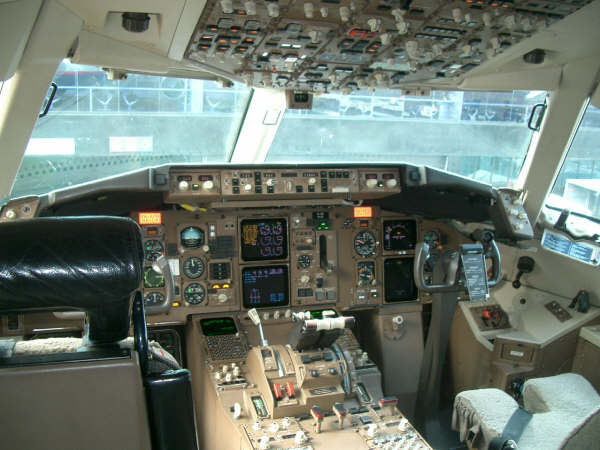 both new and existing 767 operators, allowing it to become the most successful version of the 767 family of aircraft. Airlines have placed more orders for the type than all other 767 variants combined. As of September 2014, 767-300ER deliveries stand at 583 with no unfilled orders and airlines had 495 examples in service as of July 2014. The type's main competitor is the Airbus A330-200.
both new and existing 767 operators, allowing it to become the most successful version of the 767 family of aircraft. Airlines have placed more orders for the type than all other 767 variants combined. As of September 2014, 767-300ER deliveries stand at 583 with no unfilled orders and airlines had 495 examples in service as of July 2014. The type's main competitor is the Airbus A330-200.
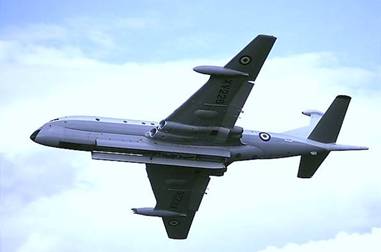 The Nimrod was arguably the best antisubmarine and Maritime Reconnaissance aircraft of the Cold War era. It was designed as a Royal Air Force maritime patrol aircraft, its major role being antisubmarine warfare (ASW), although it also had secondary roles in maritime surveillance, air-sea rescue and anti-surface warfare. It served from the early 1970s until March 2010 with 6 squadrons; 42 and 236 at RAF St. Mawgan; 120, 201, and 206 at RAF Kinloss; and 203 at RAF Luqa, Malta
The Nimrod was arguably the best antisubmarine and Maritime Reconnaissance aircraft of the Cold War era. It was designed as a Royal Air Force maritime patrol aircraft, its major role being antisubmarine warfare (ASW), although it also had secondary roles in maritime surveillance, air-sea rescue and anti-surface warfare. It served from the early 1970s until March 2010 with 6 squadrons; 42 and 236 at RAF St. Mawgan; 120, 201, and 206 at RAF Kinloss; and 203 at RAF Luqa, Malta
The development of the Nimrod patrol aircraft began in 1964 as a project to replace the Avro Shackleton. The Nimrod design was based on that of the Comet 4 civil airliner which had reached the end of its commercial life. The Nimrods were not modified Comets; rather they took the design of the Comet, modified it extensively, and then built new aircraft, which became the Nimrods. The Comet's turbojet engines were replaced by Rolls-Royce Spey turbofans for better fuel efficiency, particularly at the low altitudes required for maritime patrol. Major fuselage changes were made, including an internal weapons bay, an extended nose for radar, a new tail with electronic warfare (ESM) sensors mounted in a bulky fairing, and a MAD (Magnetic anomaly detector) boom. After the first flight in May 1967, the RAF ordered 46 Nimrod MR1s. The first example (XV230) entered service in October 1969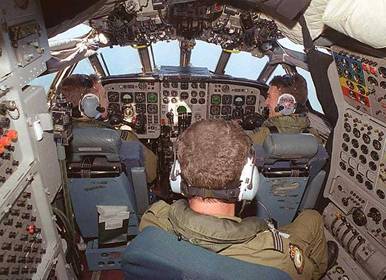
The Nimrod was the first jet-powered Maritime Patrol Aircraft (MPA). Jet engines are most economical at high altitudes and less economical at low altitudes; the aircraft travelled to the operational area at high altitude, which was economical on fuel and fast compared to earlier piston aircraft. On reaching the patrol area the Nimrod descended to its working altitude, often as low as 200 feet (or 100 feet in wartime). Once on patrol at high weight all four engines are used, but as fuel is consumed and weight is reduced first one and then a second engine is shut down, allowing the remaining engines to be run at an efficient RPM rather than running all engines at less efficient RPM. All engines were used for travel back to base at high altitude.
The Nimrod gave sterling service during the "Cod Wars" between Iceland and the UK over fishing rights in the 1970’s. During the Falklands war (Operation Corporate), several Nimrods combed the sea for enemy submarines. The Nimrods took part in Operation Granby (the Gulf War 1990 / 1991), the NATO operations against Serbia in 1999, Operation Telic (the Iraq war in 2003 and beyond), the campaign in Afghanistan, and over Libya in 2011. They also were a routine component of British Search and Rescue (SAR) operations in the North Sea. The Nimrod had an impressive range for a Maritime Patrol aircraft of nearly 6,000 miles, and also had the longest bomb bay of any military aircraft flying. Under the wing it could carry air-to-air missiles (Sidewinder AIM-9, during the Falklands War) and air-to-surface missiles (Nord AS12, Martel, Maverick or Harpoon). In the bomb bay it could carry air dropped torpedoes, depth charges, nuclear depth bombs, naval mines, sonobuoys, and survival equipment.
This was Pete Finlay’s first operational aircraft during his RAF service and he flew the aircraft on 120 Squadron at RAF Kinloss from 1975 to 1979. He took part in the Cod Wars around Iceland in 1975 and 1976 as well as antisubmarine and reconnaissance operations, mainly over the North Sea. He also took part in many Search and Rescue operations, including the Fasnet Yacht Race disaster in August 1979.
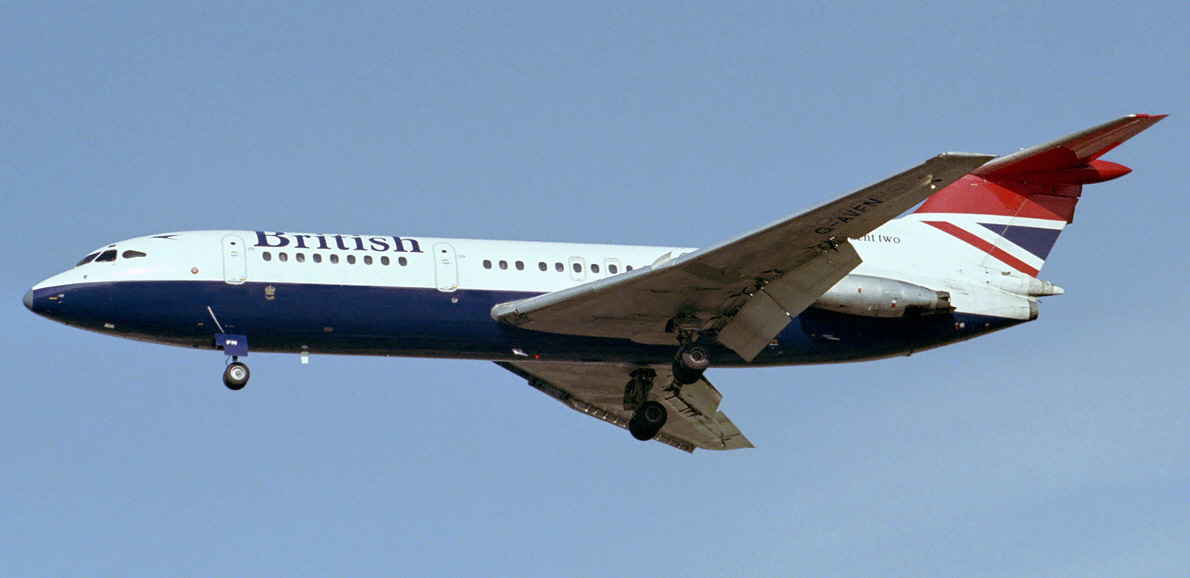 The Hawker Siddeley HS 121 Trident (affectionately called the “Ground Gripper” in British Airways service ) was a short to medium-range three-engined jet airliner designed by de Havilland and built by Hawker Siddeley in the 1960s and 1970s. The
The Hawker Siddeley HS 121 Trident (affectionately called the “Ground Gripper” in British Airways service ) was a short to medium-range three-engined jet airliner designed by de Havilland and built by Hawker Siddeley in the 1960s and 1970s. The
Trident is notable for its pioneering avionics which enabled it to become the first airliner to make a fully automatic approach and landing in revenue service in 1965 and to be the sole airliner capable of automatic landings in regular service from 1966 until versions of the Lockheed TriStar were also cleared to perform them in the mid 1970s.
Designed very tightly around a British European Airways (BEA) specification, the Trident had modest sales, with only ever 117 produced. The Trident was a jet airliner of all-metal construction with a T-tail and a low-mounted wing. It had three rear-mounted engines: two in side-fuselage pods, and the third in the fuselage tail cone, taking air in through an S - shaped duct. All versions were powered by versions of the Rolls-Royce Spey engine. The Trident was one of the fastest subsonic commercial airliners, regularly cruising at over 610 mph. At introduction into service its standard cruise Mach Number was 0.88, probably the highest of any of its contemporaries. Designed for high speed, the wing produced relatively limited lift at lower speeds. This, and the aircraft's low power-to-weight ratio, called for prolonged takeoff runs - hence the nickname “The Ground Gripper”. 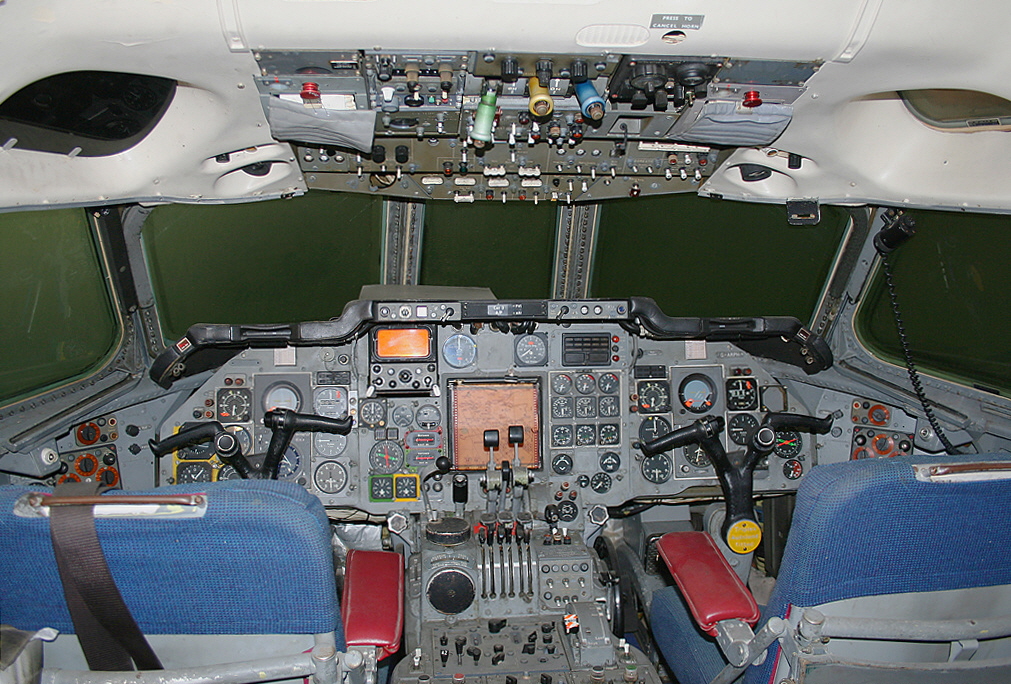
The Trident was routinely able to descend at rates of up to 4500 feet per minute in regular service. In emergency descents it was permissible to use reverse thrust of up to 10,000 rpm. The Trident's first version, the Trident 1C, had the unusual capability of using reverse thrust prior to touchdown. The throttles could be closed in the flare and reverse idle set to open the reverser buckets. At pilot discretion, up to full reverse thrust could then be used prior to touchdown. This was helpful to reduce hydroplaning and give a very short landing run on wet or slippery runways, while preserving wheel brake efficiency and keeping wheel brake temperatures low. In total, 117 Tridents were produced, while the Boeing 727, the Trident’s main competitor and built to the original airline specification for the Trident, sold 1,832 aircraft. The largest operator of the type was BEA. BEA's successor, British Airways retired their Trident fleet in the mid-1980s. In Asia, the Trident remained active in passenger service with Air China until the 1990s. As of 2014 it is believed that there are now no airworthy examples of this aircraft anywhere in the world.
Tim Orchard started his career with British Airways flying the Trident, but he has almost recovered now
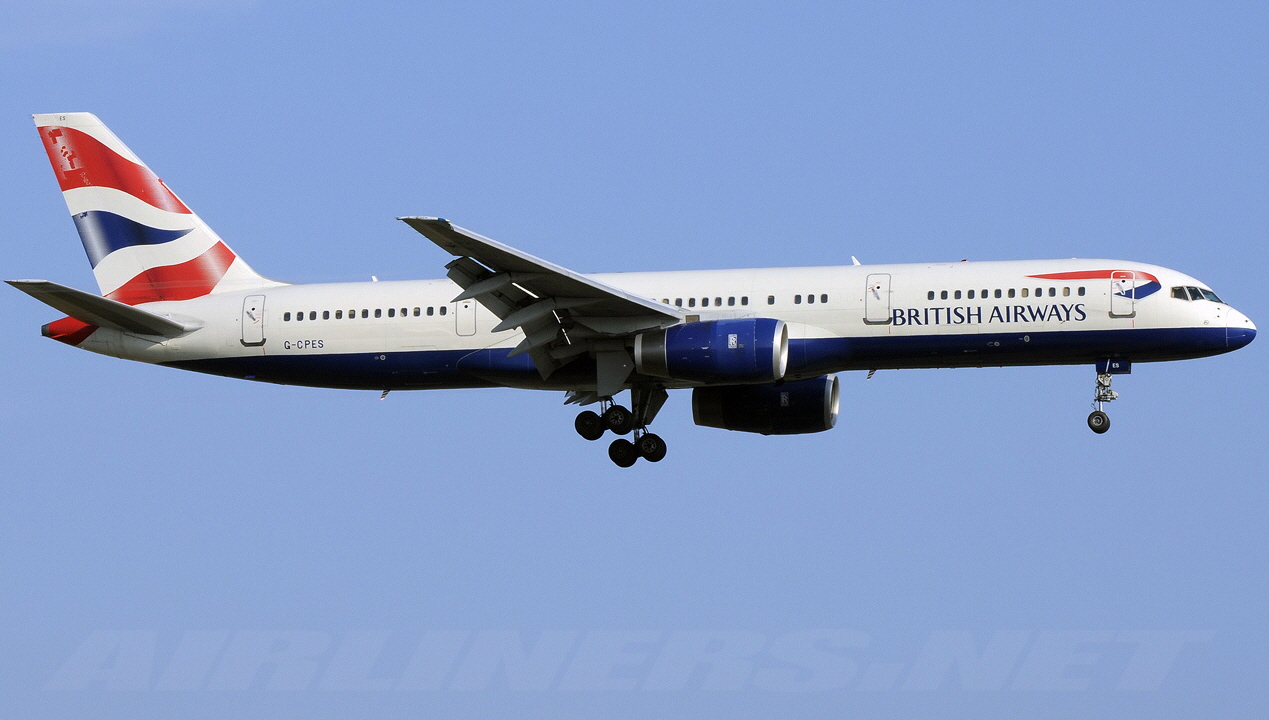 The Boeing 757 is a mid-size, narrow-body twin-engine jet airliner that was built by Boeing Commercial Airplanes from 1981 to 2004. It is the manufacturer's largest single-aisle passenger aircraft. The twinjet has a two-crewmember glass cockpit, turbofan engines, a conventional tail and, for reduced aerodynamic drag, a supercritical wing design. Intended to replace the smaller three-engine Boeing 727 on short and medium routes, the 757 can carry 200 to 289 passengers for a maximum of 3,150 to 4,100 nautical miles, depending on the variant. The 757 was designed concurrently with a wide-body twinjet, the Boeing 767, and owing to shared features pilots can obtain a common type rating that allows them to operate both aircraft.
The Boeing 757 is a mid-size, narrow-body twin-engine jet airliner that was built by Boeing Commercial Airplanes from 1981 to 2004. It is the manufacturer's largest single-aisle passenger aircraft. The twinjet has a two-crewmember glass cockpit, turbofan engines, a conventional tail and, for reduced aerodynamic drag, a supercritical wing design. Intended to replace the smaller three-engine Boeing 727 on short and medium routes, the 757 can carry 200 to 289 passengers for a maximum of 3,150 to 4,100 nautical miles, depending on the variant. The 757 was designed concurrently with a wide-body twinjet, the Boeing 767, and owing to shared features pilots can obtain a common type rating that allows them to operate both aircraft.
Production of the 757 ended on October 28, 2004, after 1,050 had been built for 54 customers. The 757-200 was by far the most popular model, with 913 built. Diminished sales amid an airline industry trend toward smaller jetliners led Boeing to end production without a direct replacement, in favour of the Boeing 737 family. The last 757 was delivered to Shanghai Airlines on November 28, 2005. In 2011, 898 of the narrow-body twinjets were in airline service, and Delta Air Lines was the largest operator, with 185 aircraft
The landing gear was purposely designed to be taller than the company's previous narrow-body aircraft in order to provide ground clearance for the longer, stretched models. In 1982, the 757-200 became the first subsonic jetliner to offer carbon brakes as a factory option, supplied by Dunlop (Concorde was the world’s first civil airliner to use a carbon braking system). The stretched 757-300 features a retractable tailskid on its aft fuselage to prevent damage if the tail section contacts the runway surface during takeoff.
Besides common avionics and computer systems, the 757 shares its auxiliary power unit, electric power systems, flight deck, and hydraulic parts with the Boeing 767. Through operational commonality, 757 pilots can obtain a common type rating to fly the 767 and share the same seniority roster with pilots of either aircraft. This reduces costs for airlines that operate both twinjets.
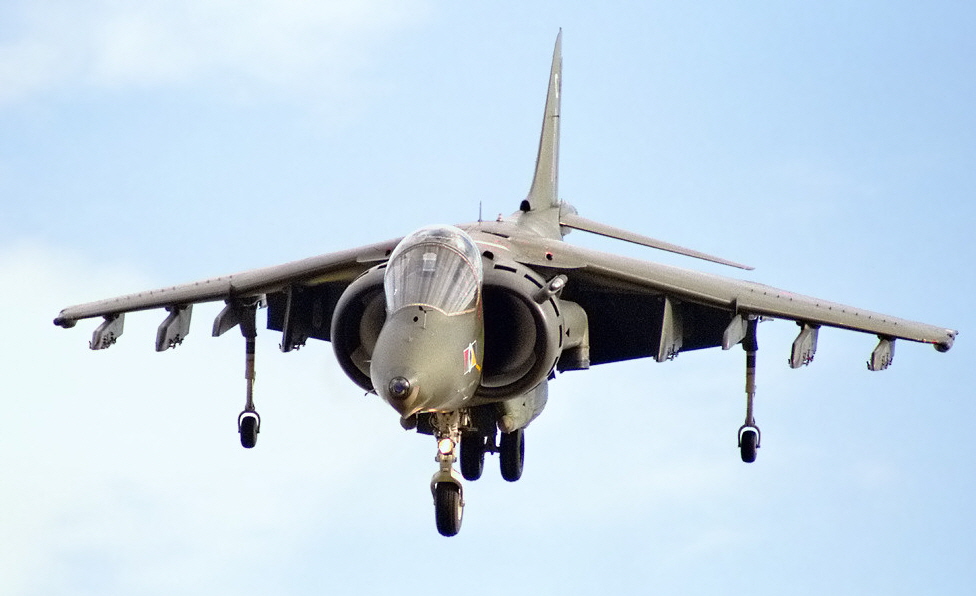 The Harrier, informally referred to as the Jump Jet, is a family of military jet aircraft capable of vertical / short takeoff and landing (V/STOL) operations. Historically the Harrier was developed in Britain to operate from ad hoc facilities such as car parks or forest clearings, avoiding the need for large air bases vulnerable to tactical nuclear weapons. Later the design was adapted for use from aircraft carriers. The Harrier is also distinct as being of modern era, yet subsonic, contrasting with most of the major Western post-World War II-era attack aircraft, which tend to be supersonic.
The Harrier, informally referred to as the Jump Jet, is a family of military jet aircraft capable of vertical / short takeoff and landing (V/STOL) operations. Historically the Harrier was developed in Britain to operate from ad hoc facilities such as car parks or forest clearings, avoiding the need for large air bases vulnerable to tactical nuclear weapons. Later the design was adapted for use from aircraft carriers. The Harrier is also distinct as being of modern era, yet subsonic, contrasting with most of the major Western post-World War II-era attack aircraft, which tend to be supersonic.
The aircraft was developed in the 1960s and formed the first generation of the Harrier series of aircraft. It was the first operational close-support and reconnaissance fighter aircraft with vertical / short takeoff and landing (V/STOL) capabilities and the only truly successful V/STOL design of the many that arose in that era. The Harrier was produced directly from the Hawker Siddeley Kestrel prototypes following the cancellation of a more advanced supersonic aircraft, the Hawker Siddeley P.1154. The Royal Air Force ordered the Harrier GR1 and GR3 variants in the late 1960s. It was exported to the United States as the AV-8A, for use by the US Marine Corps, in the 1970s.
The RAF positioned the bulk of their Harriers in West Germany to defend against a potential invasion of Western Europe by the Soviet Union; the unique abilities of the Harrier allowed the RAF to disperse their forces away from vulnerable airbases. The US Marine Corps used their Harriers primarily for close air support, operating from amphibious assault ships, and, if needed, forward operating bases. Harrier squadrons saw several deployments overseas. The Harrier's ability to operate with minimal ground facilities and very short runways allowed it to be used at locations unavailable to other fixed-wing aircraft. The Harriharrier 2er received criticism for having a high accident rate and for a time-consuming maintenance process.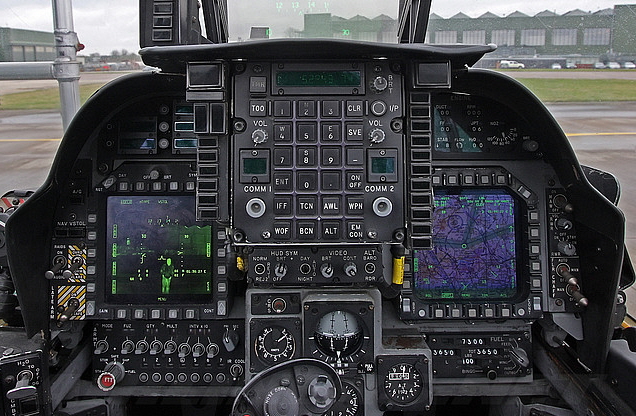
In the 1970s the British Aerospace Sea Harrier was developed from the Harrier for use by the Royal Navy on Invincible class aircraft carriers (that’s when we did have aircraft carriers). The Sea Harrier and the Harrier fought in the 1982 Falklands War, in which the aircraft proved to be crucial and versatile. The RN Sea Harriers provided fixed-wing air defence while the RAF Harriers focused on ground-attack missions in support of the advancing British land force. The Harrier was also extensively redesigned as the AV-8B Harrier II and British Aerospace Harrier II by the team of McDonnell Douglas and British Aerospace. The innovative Harrier family and its Rolls-Royce Pegasus engines with thrust vectoring nozzles have generated long-term interest in V/STOL aircraft.
The various versions of the Harrier was in service with the Royal Air Force from 1969 up until 2010, a total of 41 years. In the Royal Navy the Fleet Air Arm operated the Sea Harrier from 1980 up until 2006. In total, including aircraft destined for foreign forces (USA, Italy, India, Spain and Thailand), there were 824 Harriers built.
